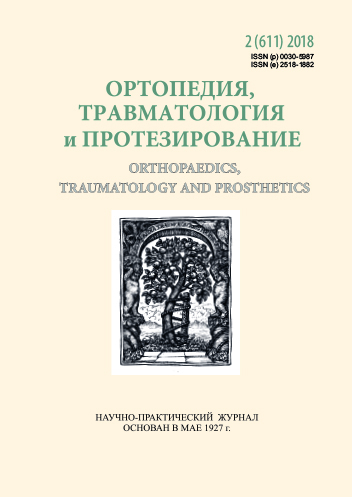Peculiarities of gunshot wound treatment of the wrist in modern conditions
DOI:
https://doi.org/10.15674/0030-59872018257-62Keywords:
wrist, gunshot wound, treatmentAbstract
The analysis of injuries as a result of military conflicts shows that gunshot wounds are 9–25 %.
Objective: to find out the peculiarities of the gunshot wound treatment of the wrist at the stages of medical evacuation on the materials of the specialized center and to determine the most optimal options.
Methods: results of the treatment of 238 victims are analyzed (average age 34.4 years) with wounds of the wrist and their consequences: fire-fighting — 135 (56.72 %), mines and explosives — 91 (38.24 %), explosives — 12 (5.04 %). Terms of hospitalization were 154 days after injury. Patients were divided into three groups: I —without complications (40.34 %); II — wound infection or tissue necrosis (32.77 %); III — consequences (26.89 %).
Results: in the I group terms of treatment were (43.8 ± 1.16) days, in the II group — (64.4 ± 2.8) with the transfer to the next stages of rehabilitation. Treatment of the patients of the III group was conducted in prolonged terms with reconstructive surgeries.
Conclusions: fire-fighting and mines and explosives wound (94.96 %) are prevailed in the structure of gunshot wounds. Timeliness, quality of primary surgical treatment of wounds, prevention of complications, planning and reconstructive surgeries on the wrist play a very important role in achievement of positive results. Inappropriate execution of the primary surgical treatment leads to an increase in the timing of treatment, appearance of additional anatomical and functional disorders and further reconstructive surgeries. Patients with isolated injuries after primary medical care of 0–II levels should be transferred to the stages of medical evacuation for the specialized care (III–IV level). In cases of complex injuries, in those who have pathological condition, emergency treatment in other medical establishments is in priority. Medical care by wrist surgeons on the place is relevant.
References
- Burianov, O. A., Strafun, S. S., Shlapak, I. P., Laksha, A. M., Gadushko, O. A., Yarmoluk, Yu. O., Mazevich, V. B., & Lykhodii, V. V. (2015). Gunshot wounds to the extremities. Traumatic shock. Methodological recommendations. – Kyiv.
- Nikolenko, V. K., Bryusov, P. G., & Dedushkin, V.S. (1999). Hand Gunshot Wounds. Moscow: Medicine.
- Smirnov, Ye. I. (1952). Gunshot wounds and limb injuries (brush and foot). Experience of the soviet medicine in the Great Patriotic War of 1941–1945. Moscow: Medgiz.
- Bykov, I. Yu., Yefimenko, N.A., & Gumanenko, Ye. K. (2009). Military field surgery: National guidance. Moscow: GEOTAR-Media.
- Maksimov, M. O. (2005). Prophylaxis and treatment of purulonecrotic sequelae and consequences of the severe gunshot wound to the extremities at the stage of specialized surgical aid. Traumatology and Orthopedics of Russia, 2(35), 26–34.
- Nikolenko, V. K. (2006). Initial surgical treatment of hand gunshot wounds. Herald of Traumatology and Orthopedics named after N. N. Priorov, 2, 55–59.
- Yeloyev, R. M. (2010). Modern approaches to the diagnosis and treatment of gunshot wounds to the extremities (Quality of Medical Aid). Moscow.
- Strafun, S. S., Borzykh, O. V., Borzykh, N. O., Kurinnii, I.M., Gayko, O. G., & Laksha, A. A. (2017). Tactics of surgical treatment of the wounded persons with the gunshot polystructural injuries to an upper extremity at the level of specialized aid. Litopys Traumatologii ta Orthopedii, 1–2, 21–27.
- Pirogov, N. I. (1994). Basics of military field surgery (pp. 174–175). Moscow.
- Emergency war surgery. (2015) .Emergency war surgery, Ukrainian edition. This vers. of Emergency war surgery (4th ed., 2013) Washington, D.C.: Office of the Surgeon General, US Army, Falls Church, Virginia, USA. Kyiv.
- Kapustin, R. F., & Gombliyevskii, D. V. (2004). Gunshot wounds to the extremities. Methodological recommendations. Minsk: BSMU.
- Bunnell, S. (1955). Hand surgery. Washington, D.C.: Office of the Surgeon General Department of the US Army.
- Burianov, O. A., Hrytsai, M. P., & Omelchenko, T. M. (2017). Selection of antibacterial therapy in patients with open gunshot injuries to the extremities and their sequelae. Herald of Traumatology and Orthopedics, 1–2, 113–118.
Downloads
How to Cite
Issue
Section
License
Copyright (c) 2018 Oleksandr Loskutov, Sergey Bilyi, Ruslan Daragan

This work is licensed under a Creative Commons Attribution 4.0 International License.
The authors retain the right of authorship of their manuscript and pass the journal the right of the first publication of this article, which automatically become available from the date of publication under the terms of Creative Commons Attribution License, which allows others to freely distribute the published manuscript with mandatory linking to authors of the original research and the first publication of this one in this journal.
Authors have the right to enter into a separate supplemental agreement on the additional non-exclusive distribution of manuscript in the form in which it was published by the journal (i.e. to put work in electronic storage of an institution or publish as a part of the book) while maintaining the reference to the first publication of the manuscript in this journal.
The editorial policy of the journal allows authors and encourages manuscript accommodation online (i.e. in storage of an institution or on the personal websites) as before submission of the manuscript to the editorial office, and during its editorial processing because it contributes to productive scientific discussion and positively affects the efficiency and dynamics of the published manuscript citation (see The Effect of Open Access).














